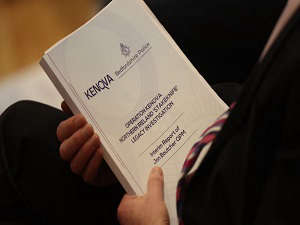
By David Young, PA
Calculated A-level grades awarded in Northern Ireland have seen pupil performance increase across all grades.
The overall pass rate of pupils achieving an A*-E grade rose by 0.8% to 99.1%.
The percentage of pupils achieving the top A* grade increased by 1% to 9.8%, while those achieving A* or A grades rose by 2.3% to 33.2%.
Female students again outperformed their male counterparts at the highest grades, with the gap broadly in line with recent years.
The calculated system also saw performance at AS level improve on 2019.
The percentage attaining a top A grade rose by 2.1% to 29.4%.
Those attaining an A-E grade rose by 0.9% to 96.4%.
The majority of the results (86%) were issued by the Northern Ireland awarding body, the Council for the Curriculum, Examinations and Assessment (CCEA).
The remaining 14% of results were from exams set by other UK awarding bodies.
There were 27,791 A-level results issued in the region on Thursday morning.
Following the cancellation of exams in March due to the Covid-19 pandemic, the exam bodies had been instructed by Stormont Minister for Education Peter Weir to ensure the calculated results in 2020 were broadly in line with performance in recent years.
While an increase has been recorded, the CCEA is content the rise is not significant enough to impact the integrity of the results set.
Data indicates that the increases in attainment would have been significantly higher if the predicted grades assessed by teachers were used without standardisation.
Teachers were asked to predict the grades of all their pupils.
In 96.7% of cases, their estimates either matched or were within one grade of the final result awarded following standardisation.
Of those, 58% of the results matched exactly.
In 37%, teachers were over-optimistic in their prediction, while in around 5% of tests they underestimated the result.
While that will see many of the grades issued on Thursday being lower than those predicted by teachers, the match rate is higher than last year.
Teachers are asked to predict grades every year in Northern Ireland as part of normal assessment procedures.
In 2019, around 46% of grades match the results attained by pupils and 40% proved overly optimistic.
The CCEA standardisation model asked teachers to give a predicted grade for their pupils and then rank them in order within their class.
The exams body then used other data to standardise the results.
For A-levels, the CCEA model used pupils' AS level results, making adjustments for those who had applied to take resits.
For AS results, the pupils' GCSE results were used, as was the performance by their school over the previous three years.
Commenting on the results, CCEA chief executive Justin Edwards said: "Since the cancellation of the exams, it has been a very unsettling and challenging period for the education community, particularly our students.
"Northern Ireland's students, and those across the UK, Ireland and further afield, due to Covid-19 were unable to sit their exams, as has been commonplace for so many before, and will be for so many in the future.
"All of us at CCEA, working closely with the education community, have strived to ensure that students are able to progress this year.
"As a result of this collaborative work, we have delivered grades to students which we predict they would have achieved had they sat the examinations and which carry the same value as in previous years.
"Northern Ireland students have seen slight increases across grades, which are comparable with previous year-on-year performance for this particular year group."
He added: "The grades received by students this morning will enable them to progress to the next stage of their journey, be it in education or employment. We wish them all every success."


 Bikers to descend on Westminster for veterans protest against Legacy Act repeal
Bikers to descend on Westminster for veterans protest against Legacy Act repeal
 Guidance sought over future of colourful parakeets in Belfast park
Guidance sought over future of colourful parakeets in Belfast park
 Woman released after questioning over pipe bombs in Co Down
Woman released after questioning over pipe bombs in Co Down
 Suspended chief constable will not be prosecuted over alleged sexual offences
Suspended chief constable will not be prosecuted over alleged sexual offences
 MI5 files not deliberately withheld from Stakeknife probe, review concludes
MI5 files not deliberately withheld from Stakeknife probe, review concludes